Butterflies of the Adirondacks:
Common Wood-Nymph (Cercyonis pegala)
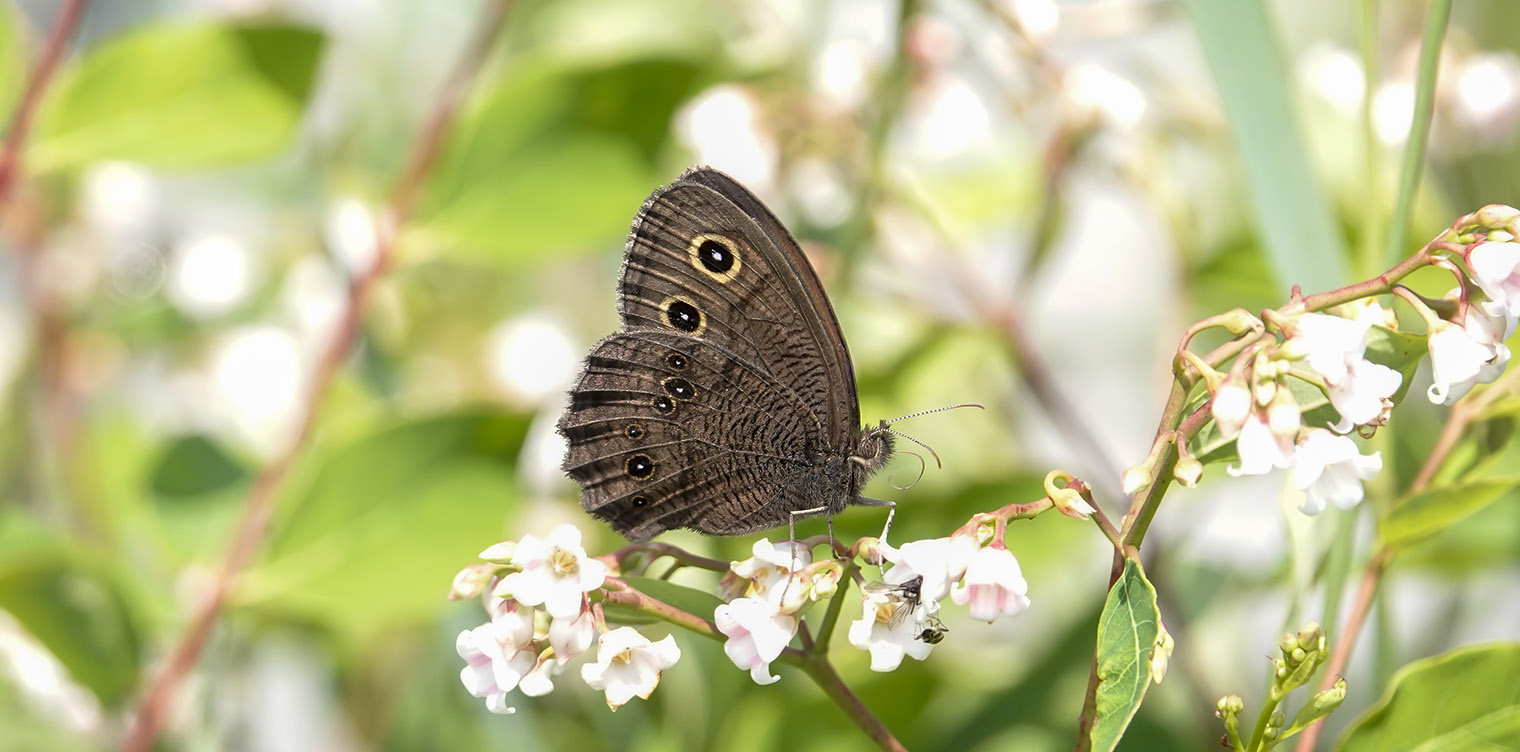
Common Wood-Nymphs (Cercyonis pegala) are medium-sized, brown butterflies seen in brushy fields and woodland edges throughout the Adirondacks in July and August.
The Common Wood-Nymph is a Satyr; it is a member of the subfamily Satyrinae (Satyrs and Wood-Nymphs). This subfamily includes about 50 species in North America. [1] The Satyrs are medium-sized butterflies, often brown with one or more eye spots; they which usually perch with their wings closed. [2] Other Satyrs found in the Adirondack Park include the Common Ringlet, Eyed Brown, and Northern Pearly-eye.
The Common Wood-Nymph is quite variable in appearance. Some of its geographic forms were once considered to be full species. The taxonomic status changed after a 1969 study by Thomas Emmel; he proposed a single species (Common Wood-Nymph), with a series of subspecies. [3]
- Current listings include 18 subspecies of Common Wood-Nymph. [4] The one we see in the Adirondacks is Cercyonis pegala nephele, which lacks the large yellow patch on the underside of its fore wing.
- The genus name (Cercyonis ) is said to be derived from Cercyon, the son of Poseidon in Greek mythology. [5]
Other non-scientific names for this species include Goggle Eye, Large Wood Nymph, and Blue-eyed Grayling. [6] [7] The latter name is a reference to the fact that the center of the eye spots sometimes appears bluish in color. [8]
Common Wood-Nymph: Identification
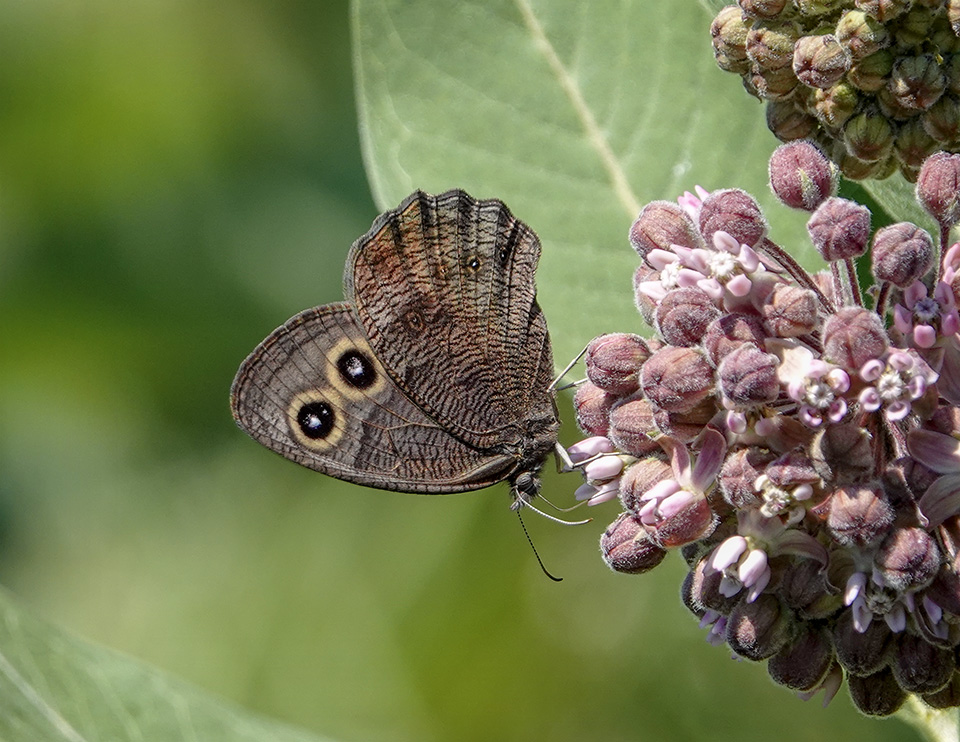
Adult Common Wood-Nymphs are a medium-sized, brown butterfly with rounded wings. [9] The base color ranges from dark brown to light cocoa brown. [10] With a wingspan of 1¾ to three inches, [11] the Wood Nymph is smaller than a Monarch or Canadian Tiger Swallowtail, but larger than an Eastern Tailed-Blue. Female Common Wood-Nymphs tend to be somewhat larger and lighter in color than the males.[12] [13] The eyes are brown.
The Common Wood-Nymph has scalloped edges on the hind wings. [14] [15] From both above (the dorsal surfaceDorsal surface: The top side of a wing. ) and below (the ventral surfaceVentral surface: The underside of a wing. ), the fore wing has two prominent eye spots. Each eye spot has a white pupil. The hind wing has up to three small eye spots above and up to six below. although the hind wing may lack eye spots entirely. Females frequently lack the smaller eye spots on the hind wing. [16] [17] The subspecies pegala has a prominent yellow or orange fore wing patch that stands out against the dark brown of the wings. Our subspecies (nephele) has a reduced or absent yellow patch and is generally smaller. [18] [19]
Adult Common Wood-Nymphs in our area, which lack the distinctive orange-yellow patch, may be confused with two other Satyrs that fly in the Adirondack region; the Northern Pearly-eye and the Eyed Brown.
- The Northern Pearly-eye is a little smaller than the Common Wood-Nymph. From below, the Northern Pearly-eye has four or five eye spots on the fore wing. and six eye spots on the hind wing which are surrounded as a group by one continuous white line (not present in the Common Wood Nymph). [20] [21]
- The Eyed Brown is also a bit smaller than the Common Wood-Nymph. It is pale brown with nearly a dozen black submarginalSubmarginal: Just inside the outer margin (edge) of the wing. eye spots from below.[22]
A third Satyr that flies in the Adirondacks – the Common Ringlet – is unlikely to be confused with the Common Wood-Nymph. The Common Ringlet is considerably smaller, is muted orange and gray-brown in color, and has only one small, dark eye spot on the ventral surfaceVentral surface: The underside of a wing. . [23]
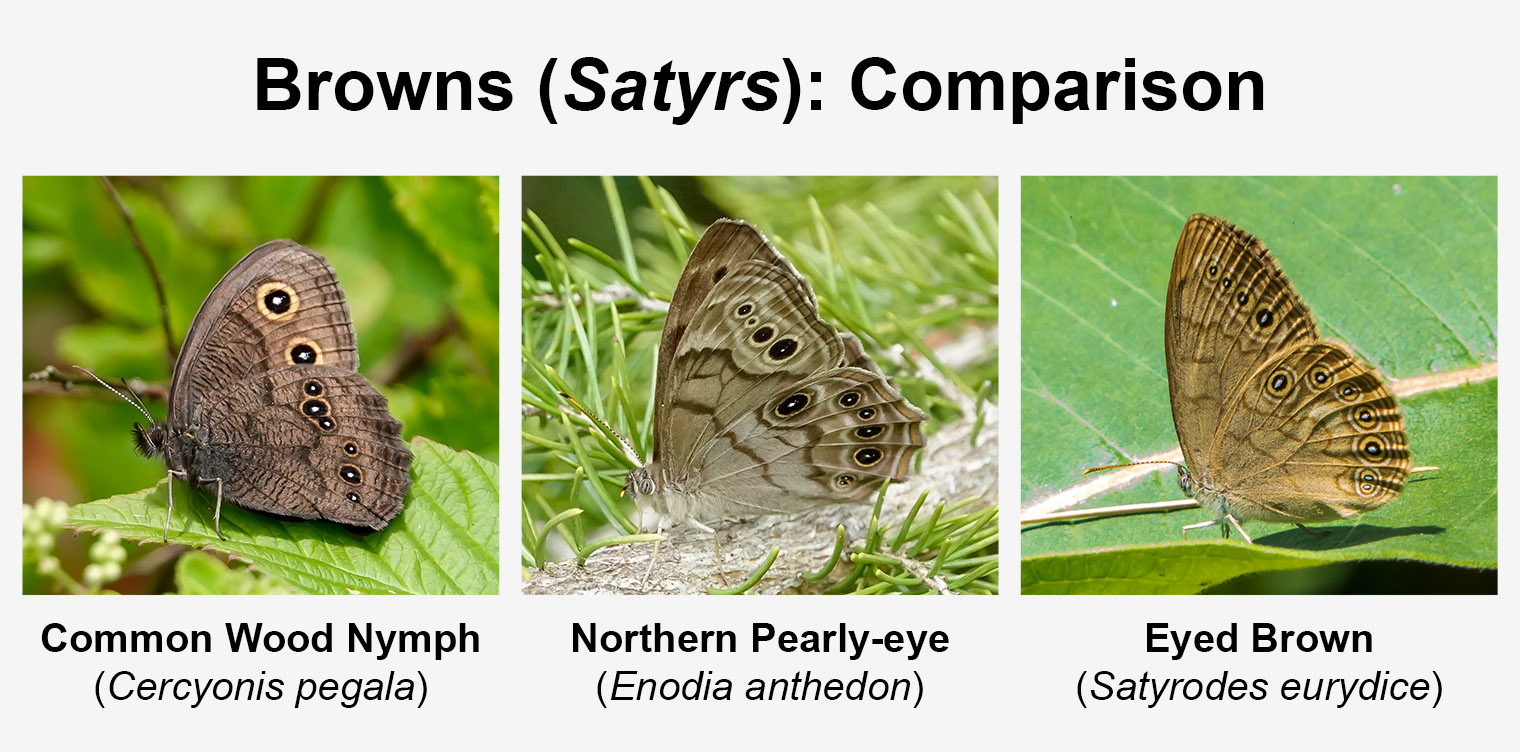
The eggs of the Common Wood-Nymph are yellow; they turn tan in a few days and develop orange-brown or pinkish mottling. [24] They are barrel-shaped and ribbed. [25]
The caterpillar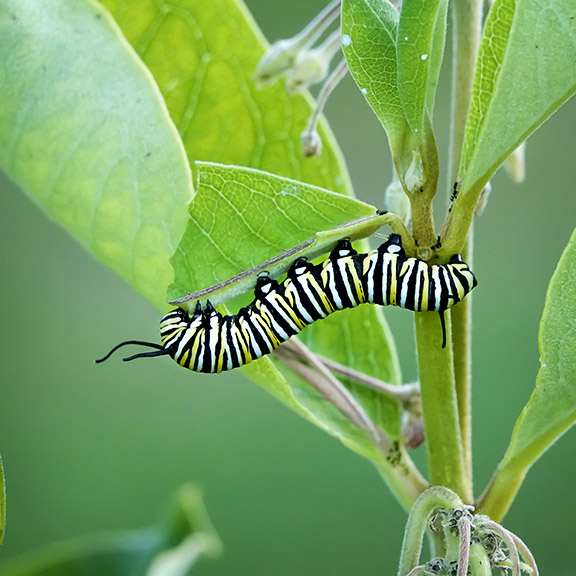 Caterpillar: Butterflies and moths develop through a process called metamorphosis, which entails four states: eggs, caterpillar (larva), pupa, and adult. The caterpillar, representing the second state in the life cycle, hatches from the egg. Its primary activity is eating. The caterpillars first eats its eggshell and then begins consuming the leaves on which the egg was laid. Newly-born caterpillars are very small and expand as they start growing. Because the exoskeleton does not stretch, the caterpillar grows by molting (shedding its skin). The stages between larval molts are called instars. of the Common Wood-Nymph is green or yellowish green with several somewhat paler lateral stripes. [26] The caterpillar is covered with long, fine, pale hairs and has a green, rounded head without horns. [27] [28]
[29]
[30]
Caterpillar: Butterflies and moths develop through a process called metamorphosis, which entails four states: eggs, caterpillar (larva), pupa, and adult. The caterpillar, representing the second state in the life cycle, hatches from the egg. Its primary activity is eating. The caterpillars first eats its eggshell and then begins consuming the leaves on which the egg was laid. Newly-born caterpillars are very small and expand as they start growing. Because the exoskeleton does not stretch, the caterpillar grows by molting (shedding its skin). The stages between larval molts are called instars. of the Common Wood-Nymph is green or yellowish green with several somewhat paler lateral stripes. [26] The caterpillar is covered with long, fine, pale hairs and has a green, rounded head without horns. [27] [28]
[29]
[30]
The chrysalisChrysalis: The hard outer shell of a pupa. of the Common Wood Nymph is green or yellow-green with pale white or yellow stripes and bands. [31] [32] [33] It is said to be rather plump. [34]
Common Wood-Nymph: Life History
Male Common Wood-Nymphs patrol for females with an erratic flight, usually in grassy areas near trees. [35] [36] Females lay their eggs singly on host plantHost Plant: The food plant of a caterpillar. Most species of butterfly will only eat a single plant (or group of related plants) as caterpillars. The particular plant that a caterpillar will eat is called the host plant for that species of butterfly. leaves. [37] The eggs hatch in 9-10 days (depending on temperature), but the caterpillars do not feed at that time, but go into diapauseDiapause: A period of inactivity and reduced physiological function, usually triggered by environmental cues, like changes in daylight, temperature, or food availability. More commonly occurs in caterpillars or chrysalises. and hibernate until spring. [38 [39] [40] At that time, they emerge to complete their development, feeding on a wide variety of grasses, including bluestem grasses (Andropogon), Purpletop, Kentucky Blue Grass, [41] [42] [43] [44] [45] The caterpillars do not build nests. [46] PupationPupate: to transform from a caterpillar to a chrysalis. occurs on the host plant. Adults emerge in 12 to 20 days. [47]
Males are said to live only a few weeks. They die soon after mating. [48] Females may live for several months, laying their eggs late in the season, usually just before the onset of cooler weather. [49] [50]
Adult male Common Wood-Nymphs are seldom seen taking food of any kind, [51] while females have been recorded nectaring on various plant species, such as Steeplebush, Spreading Dogbane, Spotted Knapweed, Common Milkweed, Monarda, Echinacea, Gaillardia, Rudbeckia, fleabane, mint, sunflowers, and geraniums. [52] [53] [54] Adult Common Wood-Nymphs are said to nectar less than most other butterflies, but more than most other Satyrs. [55] [56] This species also consumes the juices of rotting fruits and fungi. [57]
Like many other Satyrs, the Common Wood-Nymph usually perches with its wings closed. [58] They open them wide when they are basking early in the morning or at times when the weather is cloudy. [59]
Common Wood-Nymph: Habitat and Range
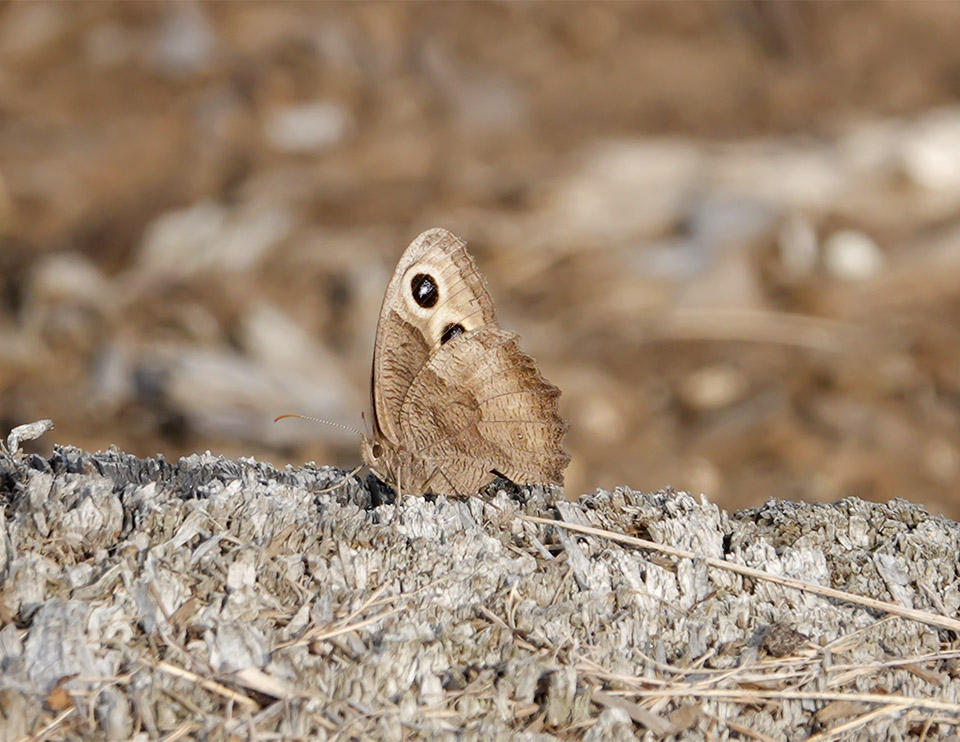
The range of the Common Wood-Nymph covers most of the continental US, with the exception of parts of the Southwest and Texas, the southern peninsula of Florida, and northern Maine. [60] [61] In Canada, this species can be found in every province except Newfoundland. It has been seen mainly in the southern parts of the provinces bordering the US, including Quebec, Ontario, Alberta, Manitoba, Nova Scotia, New Brunswick, British Columbia, and Saskatchewan. [62] [63]
In terms of habitat, the Common Wood-Nymph is said to be a generalist. [64] It is widespread and highly adaptable.
Despite its name, the Common Wood-Nymph is not normally a woodland butterfly. [65] It prefers open, sunny habitats. Throughout its range, the Common Wood-Nymph is found in a wide variety of habitats, including prairies, meadows, open bogs, marshes, dry gullies, power line rights-of-way, old fields, along roadsides and slow-moving watercourses, or on woodland edges. [66] [67] [68]
Common Wood-Nymph: Flight
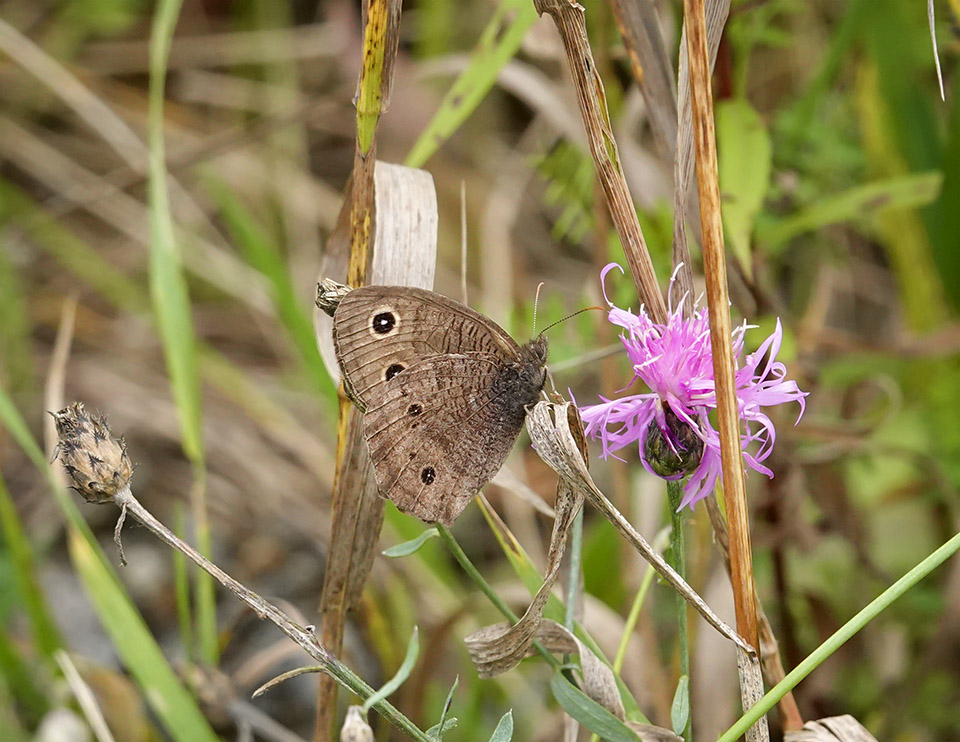
The flight period of Common Wood-Nymphs, as with all butterflies, varies with region and probably shifts from year to year. The Common Wood Nymph has only one generation. [69] [70]
- In Wisconsin, the Common Wood-Nymph flies from late June into early September. [71]
- There is one broodBrood: A single generation of butterflies, hatched from the eggs laid by females of the previous generation. Members of a brood fly during roughly the same time period. in Massachusetts, flying from early July to early September. [72]
- In Vermont, there is one brood flying mainly from mid-July through late August. [73]
- In Canada, the Common Wood-Nymph's flight season is from late June to early September. [74]
- In the New York City area of New York State, there is one brood, with Common Wood-Nymphs seen mainly from late June through mid-August. [75]
The flight period and abundance of the Common Wood-Nymph within the Adirondack Park can only be roughly estimated, based mainly on a limited number of verified sightings on Butterflies and Moths of North America (BAMONA) and reported observations on iNaturalist.
- The advantage of iNaturalist is that it is a popular citizen science web site that attracts many observers, in part because it covers both plants and animals (making it easy for people to record all of their observations in one place) and in part because the process of submitting an observation is very easy. The disadvantage is that an individual observation can achieve "research-grade" status by having the identification confirmed by the observer and one additional individual, who may or may not have expertise in that particular taxon.
- The advantage of BAMONA is that sightings are verified by regional specialists who are recognized experts. The disadvantage is that there are fewer sighting records for most species, partly because the site covers only butterflies and moths and partly because the process of submitting a sighting is more time-consuming.
- Both data sets share a common problem of citizen science: reported trends may reflect trends in the number of observers and their willingness to submit reports, not the abundance of the butterfly in question.
With these caveats in mind, it appears that Common Wood-Nymphs are on the wing in the Adirondack Park from at least mid-July through early September.
- Common Wood-Nymphs have been intermittent guests at the Paul Smith's College VIC Native Species Butterfly House, which collects its butterfly and moth residents from the immediate area. [76] This species was not listed in the Daily Species Checklist for 2012. In 2013, Common Wood Nymphs were logged as present for only four days, in late August. In 2015, they were logged as present 22 days, from late July through late August. In 2016, the Common Wood Nymph was logged as present 28 times, from mid-July through mid-August.
- BAMONA lists 115 verified sightings of Common Wood-Nymphs in New York State; 23 are in one of the twelve counties with area within the Adirondack Park. The Adirondack sightings range from early July to early September. [77]
- On the iNaturalist data base, there have been 350 research grade observations of adult Common Wood-Nymphs in New York State; 46 are within the Adirondack Park Blue Line. [78] This compares to the 461 research-grade observations within the Adirondack Park for the most popular and abundant butterfly: the Monarch. The observations for the Common Wood-Nymph extend from July to early September. [79] [80] [81] [82] [83] [84]
References
- Susan Grimm Hanley. Interpretive Naturalist, Paul Smith's College Native Species Butterfly House. Species Logbooks.
- Butterflies and Moths of North America. Species Profiles. Common Wood-Nymph. Cercyonis pegala. Retrieved 9 December 2019.
- Butterflies and Moths of North America. Sighting Records. Common Wood-Nymph. Cercyonis pegala. 7/28/2005; 7/18/2011; 8/1/2014; 8/1/2014; 8/8/2014; 7/21/2015; 8/23/2015; 7/3/2016; 7/20/2018; 7/27/2019; 7/30/2019; 7/31/2019; 8/12/2019; 8/14/2019; 8/12/2019 8/15/2019; 8/21/2029; 9/4/2019. Retrieved 11 December 2019.
- iNaturalist. Adirondack Park Sightings. Common Wood-Nymph. Cercyonis pegala. Retrieved 18 August 2021.
- iNaturalist. Adirondack Park Sightings 2016. Common Wood-Nymph. Cercyonis pegala. Retrieved 19 July 2021.
- iNaturalist. Adirondack Park Sightings 2017. Common Wood-Nymph. Cercyonis pegala. Retrieved 19 July 2021.
- iNaturalist. Adirondack Park Sightings 2018. Common Wood-Nymph. Cercyonis pegala. Retrieved 19 July 2021.
- iNaturalist. Adirondack Park Sightings 2019. Common Wood-Nymph. Cercyonis pegala. Retrieved 19 July 2021.
- iNaturalist. Adirondack Park Sightings 2020. Common Wood-Nymph. Cercyonis pegala. Retrieved 19 July 2021.
- iNaturalist. Adirondack Park Sightings 2021. Common Wood-Nymph. Cercyonis pegala. Retrieved 18 August 2021.
- Government of Canada. Canadian Biodiversity Information Facility. Species Bank. Common Wood-Nymph. Cercyonis pegala. Retrieved 10 December 2019.
- Government of Canada. Canadian Biodiversity Information Facility. Taxonomic Index. Family Nymphalidae. Retrieved 10 December 2019.
- Massachusetts Butterfly Club. Massachusetts Butterfly Species List. Common Wood Nymph. Cercyonis pegala. Retrieved 10 December 2019.
- Massachusetts Audubon. Butterfly Atlas Species Accounts. Common Wood Nymph. Cercyonis pegala. Retrieved 10 December 2019.
- McFarland, Kent P. and Bryan Pfeiffer. Vermont Butterfly Survey. Vermont Center for Ecostudies – Vermont Atlas of Life. Common Wood Nymph. Cercyonis pegala. Retrieved 10 December 2019.
- Integrated Taxonomic Information System On-line Database. Cercyonis pegala. Retrieved 10 December 2019.
- Iowa State University. Department of Entomology. BugGuide. Common Wood-Nymph. Cercyonis pegala. Retrieved 10 December 2019.
- Wisconsin Butterflies. Common Name. Common Wood-Nymph. Cercyonis pegala. Retrieved 10 December 2019.
- Montana Field Guides. Montana Natural Heritage Program. Common Wood-Nymph. Cercyonis pegala. Retrieved 10 December 2019.
- Ross Layberry, Peter Hall, and Don Lafontaine. The Butterflies of Canada (University of Toronto Press, 1998), pp. 216-217, Plate 18, Plate 26.
- Thomas J. Allen, Jim P. Brock, James P. Brock, Jeffrey Glassberg. Caterpillars in the Field and Garden: A Field Guide to the Butterfly Caterpillars of North America (Oxford University Press, 2005), pp. 110-111.
- David L. Wagner. Caterpillars of Eastern North America: A Guide to Identification and Natural History (Princeton University Press, 2010), p. 135.
- National Audubon Society. Field Guide to Butterflies (New York: Alfred A. Knopf, 1981), pp.662, 683-684, Plates 698, 725. Retrieved 10 December 2019.
- Jeffrey Glassberg. Butterflies of North America (Sterling Publishing Company, 2011), pp. 170-171.
- Jeffrey Glassberg. Butterflies through Binoculars. The East. A Field Guide to the Butterflies of Eastern North America (Oxford University Press, 1999), pp. 132, 138-139, Plate 41.
- Jeffrey Glassberg. A Swift Guide to Butterflies of North America. Second Edition. (Princeton University Press, 2017), p. 256.
- Jim P. Brock and Kenn Kaufman. Kaufman Field Guide to Butterflies of North America (Houghton Mifflin, 2003), pp. 236-237.
- Paul A. Opler. A Field Guide to Eastern Butterflies (The Peterson Field Guide Series, Houghton Mifflin Company, 1992,1998), pp. 98-99, 295, 304-305. Retrieved 10 December 2019.
- James A. Scott. The Butterflies of North America. A Natural History and Field Guide (Stanford University Press, 1986), pp. 68, 126, 240-241. Retrieved 10 December 2019.
- Donald and Lillian Stokes. Stokes Butterfly Book. The Complete Guide to Butterfly Gardening, Identification, and Behavior (Little, Brown and Company, 1991), pp. 19, 21, 84-87.
- Paul A. Opler and George O. Krizek. Butterflies East of the Great Plains: An Illustrated Natural History (The Johns Hopkins University Press, 1984), pp.186-187, Plate 36.
- Rick Cech and Guy Tudor. Butterflies of the East Coast. An Observer's Guide (Princeton University Press, 2005), pp. 208, 221.
- David Carter. Butterflies and Moths (Dorling Kindersley, Inc., 1992), p. 169. Retrieved 19 Juy 2021.
- John Eastman. The Book of Field and Roadside: Open-Country Weeds, Trees, and Wildflowers of Eastern North America (Stackpole Books, 2003), pp. 53-56.
- Thomas C. Emmel, "Taxonomy, Distribution and Biology of the Genus Cercyonis (Satyridae). 1. Characteristics of the Genus," Journal of the Lepidopterists' Society, Volume 23 (1969), pp. 165-175. Retrieved 10 December 2019.
